Because they arrive on the wall of a gallery dry, neatly framed, too often trapped in glass, it is easy to forget the liquid life of paintings and photographs. A double exhibition at the utterly charming, spacious and sunlit Quogue Gallery of tender paintings by Holland Cunningham and knockout, large-scale photographs by Barbara Vaughn offers the perfect beach-season reminder of art’s aqueous origins.
Cunningham manages to paint big on relatively modest planes of paper and canvas. Her palette is similar to Joan Mitchell, Helen Frankenthaler, Dan Christensen, and Cy Twombly—especially the white veil she modestly draws over many of her boldest touches of color. But the linear grammar is pure Hans Hofmann and Robert Motherwell, whose black guidelines trace geometric and figural suggestions like a choreographer in the wings using a finger to start the pirouette onstage.
Delicacy of touch is the order of the day, especially in Chrystie (Pink), where the toile effect of whites over oranges and pink, thinned so they run and bleed like watercolors, glimpsed in apertures to allow chromaticism to emerge, is so inviting the viewer just has to step close. At that point, the creamy edges of the paper and a signature gesture of Cunningham—the frame within the frame made by 90-degree meetings of vertical and horizontal strokes at the edge of the color field—become more apparent.
.
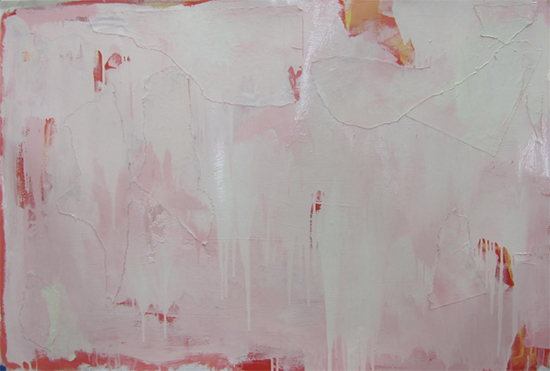
"Chrystie (Pink)" by Holland Cunningham, 2015. Mixed Media on Paper, 32.25 x 40 inches.
.
Robert Ryman was a great one for leaving the orange edges and corners of his canvases briefly exposed, and Jasper Johns likes to echo the frame, but pianissimo, pianissimo. Cunningham has a heavier hand than Ryman, but some of the poetic and compositional effects are similar.
There are many highlights that invite and reward close viewing. In Chrystie 21, for example, a moderately heavy palette knife of white adds just an impasto without the trowel load that made ski slopes in a Hofmann, and a delicate line under a patch of yellow at the upper left hand corner has a wonderful calligraphic snap to it.
.
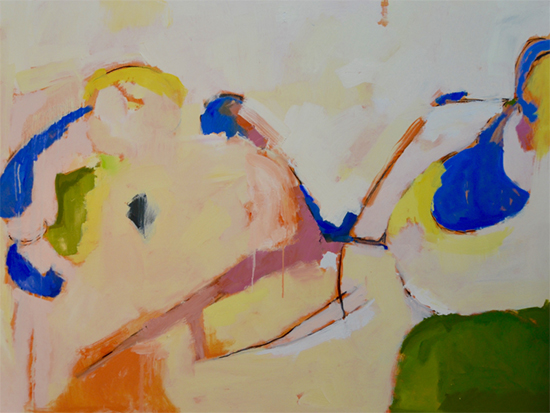
"Chrystie 21" by Holland Cunningham, 2015. Oil on Canvas, 37.5 x 49.5 inches.
.
From a distance, the work even suggests a reclining nude, and Chrystie 14 seems even more figural, much as Chrystie Yellow, the most Motherwellian moment in the show, has the feeling of windows. Its yellows, cooled with whites like an ice cube in a glass of chardonnay, balance the doubled blue verticals and horizontals, including, there in the lower left corner, her frame within the frame again.
.
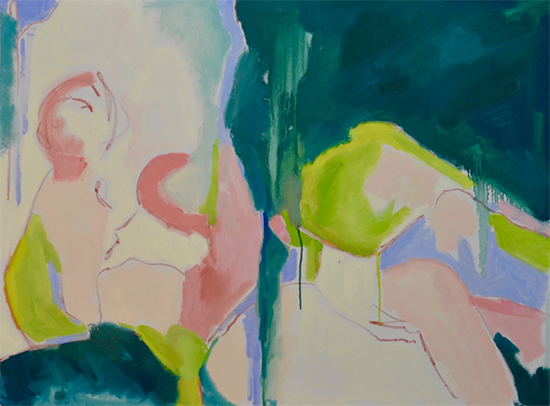
"Chrystie 14" by Holland Cunningham, 2015. Oil on Canvas, 31.5 x 41.5 inches.
.
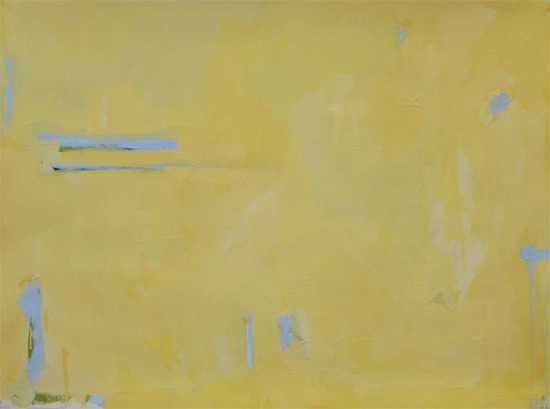
"Chrystie Yellow" by Holland Cunningham, 2015. Mixed Media on Paper, 22 x 28 inches.
.
The drips and washes that so vividly recall the liquid state of the paint as it leaves the brush are most aptly visible in the perfect summer painting, Pool, which uses four panels of Dura-lar paper (like vellum) on which she has drawn more than painted the delicate tracery of plants, layered over a firm painting of a pool edged in a blue crosshatch pattern, the most representational moment in the show. A similar idea is presented by the triptych within which leaf forms with realistic red veins are surrounded in greys and plum tones under a blue sky. The idea of the paper, and a blank section at the top and left, save it from being too easy.
My favorite piece was Chrystie 31, a more challenging oil on paper that returns to Johns and Motherwell, with a substantial corner of a blue rectangle balancing a sweeping light figure in thin paint, wash upon wash that takes the tone down to near the paper’s white.
As the titles of the works would suggest, Cunningham works on Chrystie Street (and in Quogue) but was a studio art and art history major at the University of Virginia, where her former teachers must be proud of the intelligent use she makes of the slides they showed of Monet, Piero della Francesca, the Abstract Expressionists and, I am guessing here, Lautrec (for the whites).
Her biography lists a residency at the Bau Institute in Puglia, Italy, where she bottled some of the light to bring home to Manhattan, and both the Art Students League and National Academy of Art and Design, which can take credit for the sure technique: when paints and supports are combined like this without training, the results can be grim (cracking, eczema-like skin aberrations, muddy colors). Fat over thin is the studio rule to remember as enamel, oil, canvas, paper and other media are mixed.
Barbara Vaughn, whose big, brassy photographs are in the double-height rear gallery, works in San Francisco and has a long commercial resume. The warning lights “fashion” and “lifestyle” could start blinking at the news that she is on the job for Vogue and Vanity Fair, but many Conde Nast hotshots have their gallery portfolios ready. Like Hemingway and Dos Passos, they put their Gladwellian “10,000 hours” in getting the shot their art director is demanding, then go home to print the pieces they love.
These wildly chromatic, large-scale and apparently abstract prints are blown-up details from her own photographs of Venice. I cheated and tracked the sources of the details in the catalogue, where the original long shot is offered. This makes it vastly easier, for example, to read a work like Plotos, once you know it is the reflection in the water of a fender alongside a vividly painted boat, not a top spinning on a blue field and scattering de Kooningesque ribbons of orange, yellow and white.
.
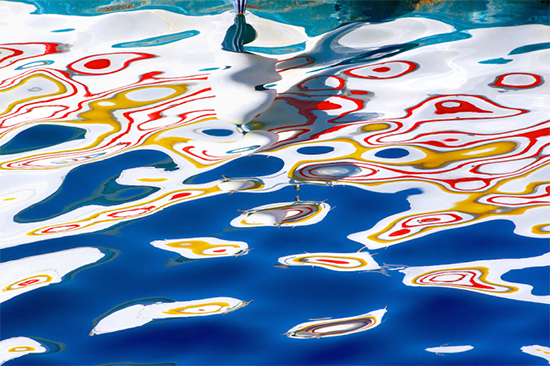
"Plotos" by Barbara Vaughn. Archival Pigment Print, 32 x 48 inches.
.
The Heraclitean flux of the series, which surrounds the viewer in bold color, captures the spectral range of hues seen in the waters of Burano, an island in the Venetian lagoon lined with houses in bright gold, red, blue and white. The striations have the fluvial sensuality of Murano glass, too, and a whole hour of a parlor game could be given over to the roster of artists who contemplated reflections in water. Among these would be, among others, Monet, Manet, Sisley, and Signac, and don’t leave out the amazing 15th century ripples along the legs of Saint Christopher in a painting by the Florentine Domenico Ghirlandaio at the Metropolitan.
Vaughn edits without Photoshopping, and the compositional eye she demonstrates is formidable. An arabesque enters the top of Korali, for example or Stropi, then descends and flows down to exit at the bottom, usually having undergone a metamorphosis from a cool or warm tone to its opposite. Korali, with a painterly range of blues, is the most abstract of the works, and the closer to abstraction the better in many ways.
Seen through a loupe, the edges that bleed red into purple with a gentle blur become part of the kinetic illusion.
.

"Korali" by Barbara Vaughn. Archival Pigment Print, 59 x 82 inches.
.
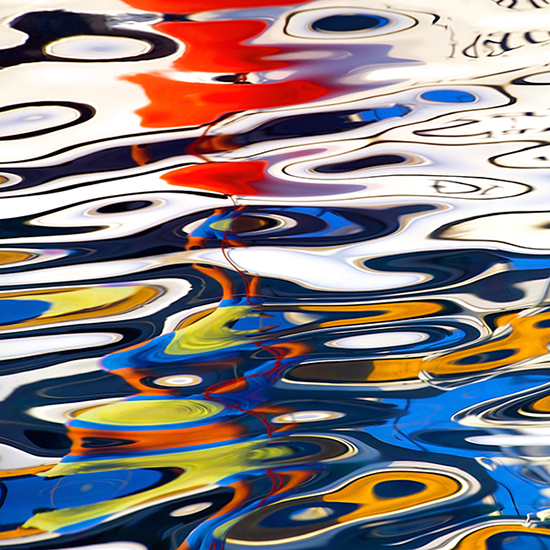
"Strofi" by Barbara Vaughn, 2013. Archival Pigment Print, 28 x 28 inches.
.
Large-scale photography of this virtuosity needs this kind of meticulous and steady printer’s hand. With Burano or the two Simaia pictures that clearly echo a Stars and Stripes at the stern of a small boat, the mimetic connection in which so much abstract art is grounded is much more clear. Although it was close to July 4, a little of the flag pattern on a blue ground goes a long way (the red and white piece not based on the flag, Levostasio II, catches the texture of ridges from a red-and-white striped building). When Vaughn’s fearless chromaticism works its magic, often in a left-to-right rhythm that shimmies like the surface of the water, the hallucinatory effect is irresistible.
.

"Burano" by Barbara Vaughn, 2012. Archival Pigment Print, 42 x 60 inches.
.
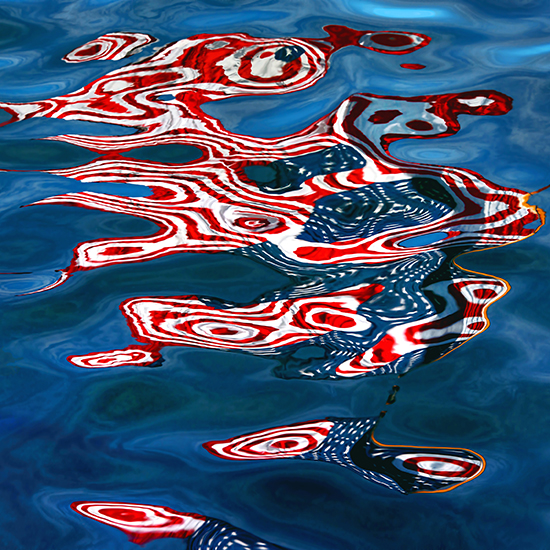
"Simaia" by Barbara Vaughn. Archival Pigment Print, 42 x 42 inches.
.
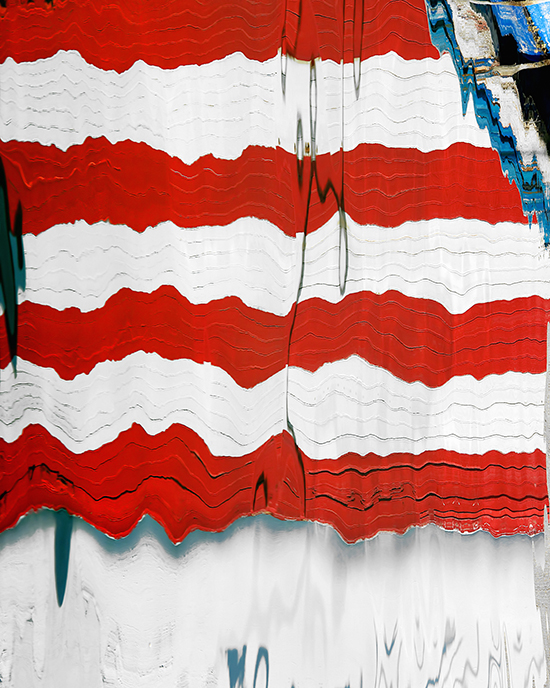
"Lemvostasio II" by Barbara Vaughn, 2014. Archival Pigment Print, 50 x 40 inches.
.
The exhibition title, Optasia, is Greek for “vision or apparition” and the artist, in the gallery’s press release, credits it with capturing “the sense of what I see in fleeting moments of the reflections I photograph.” The classy Classicism of the titles attests to the solid literary education she received at Princeton, where she might have read, with the great Wallace Stevens scholar A. Walton Litz, who chaired the English department in her era, these wonderful lines from the Stevens poem “Descriptions Without Place”:
Nietzsche in Basel studied the deep pool
Of these discolorations, mastering
The moving and the moving of their forms
In the much-mottled motion of blank time.
His revery was the deepness of the pool,
The very pool, his thoughts the colored forms,
The eccentric souvenirs of human shapes,
Wrapped in their seemings, crowd on curious crowd,
In a kind of total affluence, all first,
All final, colors subjected in revery.
____________________________
BASIC FACTS: “Barbara Vaughn: Optasia” and “Holland Cunningham: The Chrystie Paintings” are on view through July 20, 2015 at the Quogue Gallery, 44 Quogue Street, Quogue, N.Y. www.quoguegallery.com.
____________________________
Copyright 2015 Hamptons Art Hub LLC. All rights reserved.
